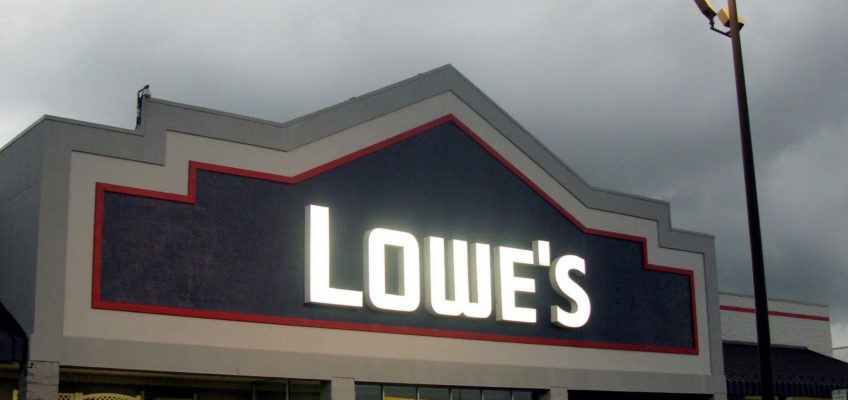Big-box retailers’ new tactic to slash their taxes is the latest example of why cities are better off saying no to the boxes and cultivating Main Streets instead.
In February, the library in Marquette, Mich., announced that it was cutting its hours.
It wasn’t that its Sunday programming was any less popular, or that it had gotten the short end of the stick in next year’s budget planning. Instead, thanks to a new method that big-box stores are using to game the tax system, Marquette Township owed a $755,828.71 tax refund to the home improvement chain Lowe’s. Essential services like the library, the school district, and the fire department were on the hook to pay for it.
The Peter White Public Library would now be closed on Sundays.
Marquette has been hit hard by a tactic that the country’s biggest retailers are using to slash their property taxes. Known as the “dark store” method, it exemplifies the systematic way that these chains extract money from local governments. It’s also the latest example of the way that, even as local governments across the country continue to bend over backwards to attract and accommodate big-box development, these stores are consistently a terrible deal for the towns and cities where they locate.
Marquette is one of the countless places that has bought into big-box economic development. Over the years, the township in the Upper Peninsula of Michigan spent millions extending water mains, law enforcement, and other infrastructure and services to its big-box commercial corridor along U.S. 41. When the Lowe’s opened there in 2008, local officials including the mayor turned out for a “board-cutting” ceremony—the home improvement center version of a ribbon-cutting.
Then, less than two years later, Lowe’s flipped the script. The mega-retailer, which reports annual net sales of about $50 billion, went to tax court to appeal its property tax assessment. Marquette had pegged the taxable value of the store, which had just been built for $10 million, at $5.2 million. In front of the Michigan Tax Tribunal, an administrative court whose members are appointed by the state governor, Lowe’s won assessments that were, instead, $2.4 million in 2010, $2 million in 2011, and $1.5 million in 2012.
“We honestly thought there had been a mistake,” says Dulcee Atherton, the assessor for Marquette Township. “We had the building permits that said it was worth $10 million. We couldn’t believe the audacity, really.”
What was worse was the methodology that Lowe’s, and the tax tribunal, had used to arrive at the lower figures.
Figuring out the value of a property can be a complicated business. In Michigan, town and county assessors typically use a property’s construction costs, minus depreciation, as a primary metric to determine its fair market value; taxable value is half that amount. Property owners sometimes prefer, instead, to use the sale prices of comparable properties. This was the approach that Lowe’s took—with a catch. Lowe’s looked at the definition of the word “comparable,” and decided to stretch it. It said that, because big-box stores are designed to be functionally obsolescent, comparable stores are those that have been closed and are sitting empty—the “dark stores” behind this method’s name.
“Unlike many other commercial properties,” the assessor hired by Lowe’s argued in court, “free standing ‘big-box’ stores like the subject [property] are not constructed for the purpose of thereafter selling or leasing the property in the marketplace.”
It’s an established part of the big-box retail model that the boxes themselves be custom-built, cheaply constructed, and disposable. If retailers decide that they need a bigger space, it’s cheaper for them to leave the old one behind and build a new one. When Walmart, for instance, opened its wave of new, twice-the-size Supercenters across the country in 2007, it left hundreds of vacant stores behind it. This means that new, successful stores like the Marquette Lowe’s are rarely the locations that are up for sale, and that when big-box stores do come on the market, it’s because they’ve already failed or been abandoned by the retailer that built them. In other words, Lowe’s was saying, it had built a property that, despite generating roughly $30 million in annual sales for the company, had very little value, and because of that, it should get a break in its property taxes.
Lowe’s went a step further. The properties that it offered up for comparison were properties that had been affected by another big-box retail tactic: deed restrictions. When big-box retailers are ready to move on to a new location, they often place these restrictions on the properties they leave behind. Designed to ensure that whoever buys the property won’t become a competitor, these restrictions limit how the store can be used, down to lists of specific items that the new occupant is banned from selling. In effect, they prevent most other retailers from moving into spaces designed specifically for retail, and so depress the values of these properties even further.*
One of the comparables used by Lowe’s, for instance, was a big-box store that, because of deed restrictions that kept out retail, had been partially converted into a go-kart track—a much less valuable use for that property. Marquette appealed the ruling, but the Michigan Court of Appeals sided with the tax tribunal, and in Dec. 2014, the Michigan Supreme Court announced that it would not hear the case.
Now, following the lead of Lowe’s, about 12 other large retail chains in Marquette have appealed their own assessments to the Michigan Tax Tribunal. These cases don’t just affect property tax revenue going forward, but can also force towns to rebate taxes already paid. So far, Marquette has had to refund over $1.5 million in taxes, money that it had already collected, allocated, and spent. The tribunal appears “likely” to rule in favor of the remaining cases, reports WNMU Public Radio. If that happens, the public services that are funded with tax dollars would have to refund big-box chains as much as $1.9 million in 2015. “This could spread like wildfire,” State Rep. John Kivela told the radio station.
It already is. In Ottawa County, Mich., for instance, big-box stores have lowered their assessments by $14.8 million. Statewide, in the last three years alone, the reduction in property taxes as stores bring appeals based on the “dark store” method has been $47 million, according to the Michigan Association of Counties. Once that revenue stream is lost, it’s lost for good. A Michigan law known as Proposal A dictates that, barring major changes to a property, increases in the taxable value of that property are capped at either 5 percent or the rate of inflation.
“That’s a staggering amount of money that’s been paid back,” says Scott Erbisch, the Marquette County Administrator. “It’s tens of millions of dollars being lost throughout the state, and once it’s gone it’s gone. It will take decades to get it back up to these levels.”
Dark Store Tactic Moves Beyond Michigan
Michigan assessors are now fielding calls from officials in other states concerned about the same thing happening to them. Already, the dark store approach has struck across the border, in Indiana.
After winning assessments in Michigan, the chain retailer Meijer brought a case at one of its most successful Indiana locations, and argued that the thriving store should be valued based on a shuttered Lowe’s and three abandoned Walmarts. Meijer got its store’s assessment slashed from $83 per square foot to $30 per square foot, and litigated the case retroactively, so that it extended back over a nine-year period. Now Marion County, where the store is located, is facing a refund of $2.4 million to Meijer.
In this case, Meijer’s lawyer was clear that this is the first play in a broader strategy. “We thought Marion County would be a good county to take a test case,” lawyer Stephen Paul told the Indianapolis Business Journal. “We picked a relatively successful store. Whatever the value is there would be the upper limit of the value across the state.”
If the dark store method becomes the norm in the state, a study commissioned by Indiana county officials found, the value of more than 17,000 commercial properties would drop by $3.5 billion. Their big-box retail owners would shift a tax burden of $120 million onto other types of taxpayers, like locally owned stores and working families.
“You have disparities being created,” says Erbisch, from Marquette. “Your local entrepreneur making a go of it, they don’t have a good way to work around their taxes. It’s setting up an unfair market, and making it harder for them to compete.”
Big-Boxes’ Long-Running Tab of Costs
While the dark store method is just catching fire in Michigan and Indiana, it’s part of a broader tax-cutting strategy that’s a familiar page in the big-box retail playbook.
As one example, take Walmart, the largest among them, which looks for tax loopholes wherever it can find them. “For every kind of tax that a retail company would normally pay or remit to support public services, Walmart has engineered an aggressive scheme to pay less and keep more,” found a 2011 report by the non-profit research organization Good Jobs First. These include using its fleet of lawyers to systematically challenge its property tax assessments, and gimmicks such as deducting rent payments made to itself through captive real estate investment trusts. Good Jobs First calculated that these tactics cost state and local governments more than $400 million a year in lost revenue, and concluded, “Walmart may be more of a fiscal burden than a benefit to many of the communities in which it operates.”
There’s also the other side of a local government’s ledger. Big-box retail is expensive to maintain. Because these stores are located outside of town centers and designed for car culture, they require local governments to extend and bolster public services and infrastructure like sewers, roads, and police forces. They also rely on these services heavily. When eight communities in central Ohio looked at the fiscal impacts of big-box retail, they found that the stores actually demanded more public services than they generated in revenue, and created a drain on municipal budgets to the tune of a net annual loss of $0.44 per square foot, or about $80,000 for a typical Walmart supercenter.
Higher demand for police departments is one example. In Port Richey, Fla., nearly half of the town’s crime emanates from the area Walmart. “The taxes that come from Walmart are not even enough to cover two police officers’ salaries,” Police Chief Robert Lovering told Vice. In an Indianapolis suburb, the number of police calls to Walmart have led the mayor to declare the store a public nuisance. “They’re draining our resources every single day,” he told the Indianapolis Star. These are not one-off examples. A 2014 study found that when Walmart located in a community, its reduction in crime slowed. And once these stores are vacant, they continue as magnets for crime and vandalism, lowering nearby property values.
Despite all of this, cities and towns continue to buy into the myth, sold to them by the mega-retailers themselves, that big-box stores spark economic development. In service of this myth, local and state governments across the country have granted at least $2.6 billion in subsidies to just six large retailers, including $160 million to Walmart and $138 million to Lowe’s, according to another study from Good Jobs First. That’s without factoring in the cost of services, which as Marquette, Mich., saw, can pile up.
The Locally Owned Alternative
If towns and cities looked beyond the conventional wisdom that the big corporations have peddled, they’d see that there’s an alternative to big-box retail. It’s a familiar option: Instead of courting chain stores that lack a stake in their communities, cities and towns can cultivate locally owned, independent business.
Locally owned retailers provide value to a community in many ways, but one of them is to the municipal accounting books. In a study that found that big-box retail generates a net deficit for taxpayers in a Massachusetts town, the researchers also discovered that specialty retail, like Main Street businesses, are the ones with a positive impact on public coffers, generating more revenue than they require to service.
Then there are the buildings that these businesses occupy. Unlike the massive, windowless buildings preferred by big-box retailers, locally owned businesses tend to locate in walkable downtowns, inside of dense and often mixed-use buildings that have a history of being adapted for many different purposes.
These buildings are the opposite of short-lived and single-use, and they’re also the ones that create far more public wealth. One consultant, Joe Minicozzi, has looked at the “per-acre” value of land, and found that, though low-density development is often hailed as the major municipal revenue generator, it’s high-density development that holds the potential for far greater wealth. Take Asheville, N.C. Minicozzi’s calculated that the city realized a per-acre return on downtown, mixed-use development that’s 800 percent greater than it sees on a large, single-use Walmart. “The result is that the community loses, both in terms of the property tax it collects and the long-term legacy of cheap single-use buildings,” Minicozzi has written. “In basic terms, we’ve created tax breaks to construct disposable buildings, and there’s nothing smart about that kind of growth.”
Back in Michigan and Indiana, communities are catching on. In Marquette, some residents have organized a boycott of the Lowe’s, and two state legislators from the area are working on a bill that will address the issue. Indiana has gone a step further. After the Meijer store ruling, state legislators quickly authored a bill to head off other cases.
“Using empty stores might fit the letter of the law, but to a reasonable person, that’s not what’s intended by a comparable sale,” says state Sen. Pete Miller, one of the bill’s authors. The policy, which was signed into law in May 2015, sets firmer guidelines for how to value big-box properties. New properties, or those less than 10 years old, should be valued using the cost approach, the bill says. Further, in cases where comparable sales are used, the comparables cannot be properties that have been sitting vacant for more than one year, or properties with deed restrictions on them, among other measures. “We’re trying to get the balance right,” says Sen. Miller.
Policies like this are essential for protecting towns and cities from the tax-gaming strategies of big-box retailers. Yet, the harrowing stories out of Michigan and Indiana also serve as a reminder of the deeper problems with big-box retail, and of how much smarter it is for communities to build durable places and stake their future on businesses that are owned locally.
—
* In Cottage Grove, Minn., for instance, a Home Depot that’s already been shuttered for seven years will only sell its space to the city if the city agrees to keep any competition out of the surrounding mall for another 15 years. The ban has left local officials fuming, reports the St. Paul Pioneer Press, which described the sale conditions as “crippling city development for the next 15 years.”
Photo by frankieleon.





